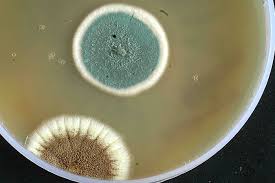
"Paecilomyces lilacinus: The Beneficial Fungus"
Share
Introduction
Deep within the soil, a silent battle unfolds. Nematodes, microscopic worm-like creatures, wreak havoc on plant roots, hindering growth and causing significant crop losses.
But a champion emerges from the microbial world – Paecilomyces lilacinus, a beneficial fungus that acts as a natural biocontrol agent against these harmful nematodes. Let's explore the fascinating world of P. lilacinus, its uses, and its applications in sustainable agriculture.
What is Paecilomyces lilacinus?
P. lilacinus is a filamentous fungus belonging to the Ascomycota phylum. It exists in the soil as spores, microscopic reproductive units that can lie dormant for extended periods. When conditions are favorable, these spores germinate and develop into thread-like structures called hyphae.

A Natural Nemesis for Nematodes: How P. lilacinus Fights Back
P. lilacinus acts as a natural predator for nematodes, particularly targeting root-knot nematodes, a major threat to various crops. Here's how it works:
Nematicide Production
The fungus produces enzymes and toxins that can directly kill nematodes.
Entrapment
The hyphae of P. lilacinus act like sticky snares, trapping nematodes that come into contact with them.
Parasitism
The fungus can parasitize nematode eggs, preventing them from hatching and developing into new generations of harmful pests.
Competition
P. lilacinus competes with nematodes for resources and space in the soil, reducing their overall population.
Benefits of Using Paecilomyces lilacinus
Safe for Humans and the Environment
Unlike chemical nematicides, P. lilacinus poses minimal risk to humans, beneficial insects, and other organisms in the soil.
Target-Specific
This fungus primarily targets nematodes, minimizing harm to other soil life.

Long-Lasting Effect
Spores of P. lilacinus can remain viable in the soil for extended periods, providing ongoing protection against nematodes.
Organic Compatibility
P. lilacinus is an organic pest control option, making it suitable for organic farming practices.
Applications of Paecilomyces lilacinus
Soil Drench
A liquid formulation containing P. lilacinus spores can be drenched into the soil around the base of plants for preventative or curative purposes.
Seed Treatment
Seeds can be coated with P. lilacinus spores before planting to provide protection from nematodes early in the plant's lifecycle.
Compost Amendment
Adding P. lilacinus to compost piles can help establish a population of the beneficial fungus in the compost, which can then be introduced to the soil.
Limitations of Paecilomyces lilacinus
Environmental Dependence
Factors like temperature, moisture, and soil composition can influence the effectiveness of P. lilacinus.
Slow Action
While effective, P. lilacinus may take some time to establish itself and reduce nematode populations.
Strain Specificity
Different strains of P. lilacinus may have varying levels of effectiveness against different nematode species.
The Future of P. lilacinus:
Research is ongoing to improve the efficacy and application methods of P. lilacinus. Scientists are also exploring the potential of combining P. lilacinus with other biological control agents for a more comprehensive approach to nematode management.
Conclusion
By harnessing the power of P. lilacinus, farmers can promote sustainable agriculture by reducing reliance on chemical nematicides and fostering a healthy soil ecosystem. This fungal friend offers a promising approach to protecting crops and ensuring a bountiful harvest.
